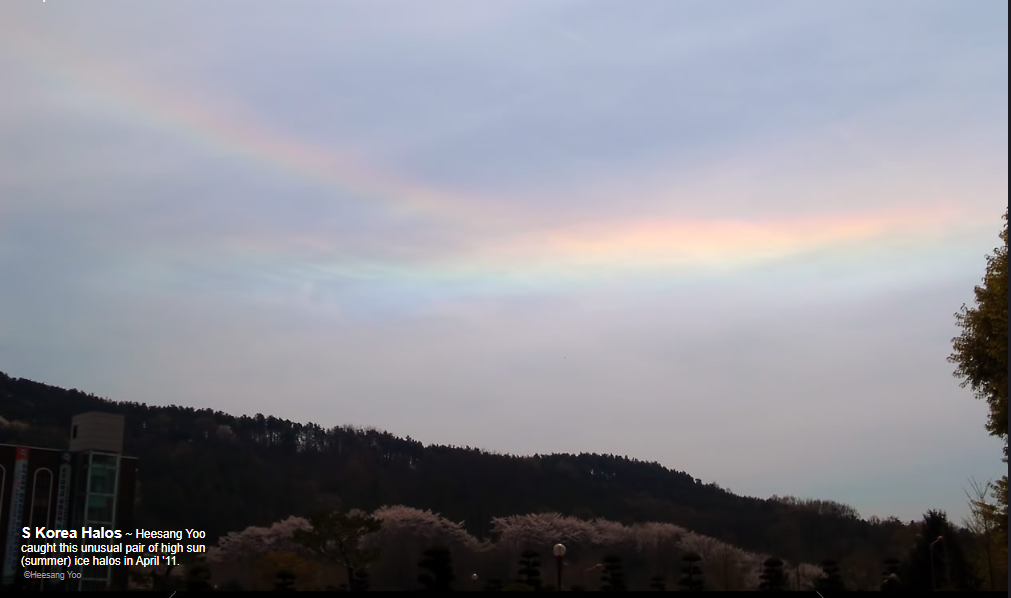OPOD - Korean Halos
OPOD - Korean Halos: A Captivating Display of Atmospheric Optics
Atmospheric optics never fails to surprise us with its breathtaking displays, and the phenomenon known as "Korean Halos" is no exception. Captured by the talented photographer Heesang Yoo in April 2011, these unique halos showcase a mesmerizing interplay of light and ice crystals against the backdrop of the South Korean sky. While the individual halos may be difficult to distinguish, their combined presence creates a captivating spectacle that leaves observers in awe.
The Korean Halos are particularly intriguing because they require specific conditions to occur. These halos can only be seen when the sun is positioned higher than 58° in the sky, marking the onset of summertime halos. This positioning allows for the optimal refraction and dispersion of sunlight through ice crystals, giving rise to the vibrant colors and distinct shapes observed in these halos.
One of the halos that form the Korean Halos display is known as the circumhorizon arc. This arc appears as a lower band beneath the sun and is produced by hexagonal plate-shaped ice crystals drifting in cirrus clouds. These crystals have their large faces almost horizontal, allowing rays of light to enter through a vertical prism side face and exit through the lower hexagonal face. The refraction and dispersion of light through facets at 90° to each other result in a wide color separation, adding to the visual allure of the circumhorizon arc.
The second halo that contributes to the Korean Halos display is the infralateral arc. This arc touches the circumhorizon arc at its right side but curves upwards and away from it on the left side. It is believed to be seen less frequently than the circumhorizon arc. The infralateral arc is produced by hexagonal column-shaped ice crystals drifting with their long axes horizontal. As rays of light enter through a prism end face and leave through a lower side face, refraction occurs through facets inclined at 90°. This refraction process creates the distinctive curve of the infralateral arc.
To provide further evidence for the presence of column-shaped ice crystals, two lower images accompanying the Korean Halos display show additional halos closer to the sun. These halos, including a circumscribed halo produced by columns, are prominent and lend support to the hypothesis of column crystal formation.
A visual representation of the Korean Halos can be seen in the accompanying HaloSim ray tracing. This simulation accurately depicts the positions of the halos relative to the sun and horizon. The circumhorizon arc maintains a constant altitude above the horizon, while the infralateral arc curves upwards on each side of the sun. Additionally, the simulation captures a vividly colorful arc beneath the sun, which could potentially be either of the halos present in the Korean Halos display.
The Korean Halos represent a captivating example of atmospheric optics, showcasing the beauty that arises from the interaction between sunlight and ice crystals. These rare displays serve as a reminder of the intricate and enchanting nature of our atmosphere. So, next time you find yourself gazing up at the sky, keep an eye out for these remarkable phenomena that add a touch of magic to our everyday lives.

S Korea Halos ~ Heesang Yoo caught this unusual pair of high sun (summer) ice halos in April '11. ©Heesang Yoo

The display is unusual because it shows two halos that when seen individually are difficult to distinguish from one another.
The halos are directly beneath the sun. They are a first glimpse of summertime halos because they both require the sun to be higher than 58°.
The lower of the arcs is a circumhorizon arc produced by hexagonal plate shaped crystals drifting in cirrus with their large faces very nearly horizontal. Rays enter a vertical prism side face and leave through the lower hexagonal face. The refraction and dispersion through facets at 90° to each other gives wide colour separation.
The other halo touching the circumhorizon arc at right but curving upwards and away from it at left is possibly seen less often. It is an infralateral arc produced by hexagonal column crystals drifting with their long axes horizontal. Rays enter a prism end face and leave through a lower side face. The refraction is again through facets inclined at 90°.
Evidence for the column crystals is provided by the two lower images that show halos closer to the sun where a circumscribed halo also produced by columns is prominent.
The matching HaloSim ray tracing shows the positions of the halos relative to the sun and horizon. The circumhorizon arc is at a constant altitude above the horizon, the infralateral arc curves upwards each side of the sun. A very colourful arc beneath the sun might be either.
Note: this article has been automatically converted from the old site and may not appear as intended. You can find the original article here.
Reference Atmospheric Optics
If you use any of the definitions, information, or data presented on Atmospheric Optics, please copy the link or reference below to properly credit us as the reference source. Thank you!
-
<a href="https://atoptics.co.uk/blog/opod-korean-halos/">OPOD - Korean Halos</a>
-
"OPOD - Korean Halos". Atmospheric Optics. Accessed on November 26, 2024. https://atoptics.co.uk/blog/opod-korean-halos/.
-
"OPOD - Korean Halos". Atmospheric Optics, https://atoptics.co.uk/blog/opod-korean-halos/. Accessed 26 November, 2024
-
OPOD - Korean Halos. Atmospheric Optics. Retrieved from https://atoptics.co.uk/blog/opod-korean-halos/.